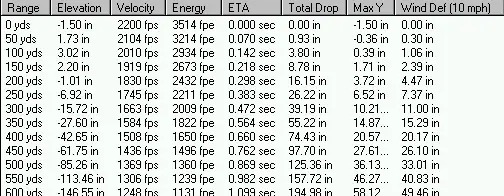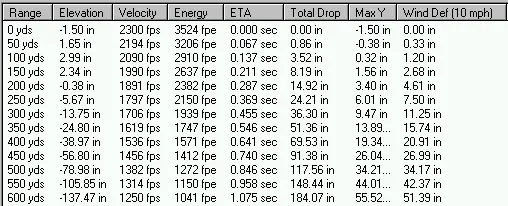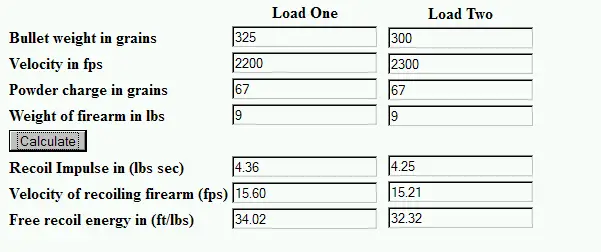


A Long Range Muzzleloading Approach
Above is an unofficial example of the top-secret "Bob Parker Experimental Muzzleloader Bullet" testing. I'm really starting to worry about Bob.
Approximate average actual shooting ballistic coefficients for the Parker Match Hunter are as follows. Ambient conditions may change this greatly, but this is a good starting point before you begin your mandatory practice, range work, and fine-tuning.
325 M/H: .400 G1
@2200 fps
300 M/H: .370 G1 @2300 fps
275 M/H: .330 G1 @2400 fps
For general shootability and practicality, without muzzle breaks that I am loudly opposed to, the target muzzle velocity is 2200 fps – 2400 fps. Sabot stress may begin at anything beyond 2400 fps, and we want to eliminate any potential consistency issues to the extent that it is possible.
The Parker Match/Hunter is the most ballistically efficient .45 caliber muzzleloading projectile ever offered. Its aggressive form factor requires both a fairly high muzzle velocity and a fast rate of twist barrel to stabilize. I've been unable to get the pinpoint accuracy I want out of 1:28 rate of twist barrels with the M/H.
This means, use a Savage 10ML-II (1:24) or wait until I can convince LHR or Remington to offer a 1:24 rate of twist barrel. For 1:28 rate of twist barrels, the 300 grain Parker Ballistic Extreme is generally the best choice, although every rifle is different: certainly no two barrels are truly identical. Target velocities and resulting exterior ballistics follow, for the 325 and 300 grain Match Hunters.

The 325 @ 2200 fps, assuming a 6 inch kill zone, has a 220 yard Maximum Point Blank Range. As a matter of fact, Mike Davidson took a Pronghorn at 715 yards with this combination, quite cleanly.

The 300 grain Match Hunter @ 2300 fps, again assuming a 6 inch kill zone, has a 228 yard Maximum Point Blank Range.
The 300 grain launched at a 100 fps faster velocity has a better trajectory than the higher BC 325 M/H. However, the 325 grain Match Hunter has slightly less wind drift. The 300 grain has a higher strike velocity, but at 500 yards the difference is only a few feet per second and at 600 yards it is essentially even.

The 300 grain Match Hunter at 2300 fps has slightly less recoil than the 325 grain MH @ 2200 fps.
In general, the 300 grain .451 Match Hunter in a short black MMP sabot is the better choice for a .50 caliber inline muzzleloader. The 275 grain Parker Match Hunter is not considered here for sabot-shooting, for the accuracy is not there. However, the 275 M/H has done quite well in sabotless applications, not the subject of this brief article.
The 300 grain Parker Match Hunter is a tough bullet with a thick, .028 inch jacket. Do not expect rapid, varmint-like bullet deformation, much less fragmentation. Expect shoot-through performance, though. On the general topic of long-range muzzleloading, I'm more "Randy Switzerland" than anything else. I neither encourage nor discourage it. As long as you can hold three inch groups at whatever range you are shooting at, it is dead animal every time. At the bench, with a stationary target at a known distance, is where it all starts. Surely, if we cannot consistently punch paper off of bag and cradle, we don't need to scare the horses and children with it anywhere else, much less hunt at those distances. The savvy hunter will consider results from the bench as "penultimate range," but adjust and reduce ranges according to field conditions: wind, shooting prone off of a back-pack, leaning against a tree, animal movement, and so forth. It is personal judgement and only the individual can make the proper call for themselves.
In rough terms, with the 2300 fps 300 grain Match Hunter loading, it is center of the body to 230 yards, and go pick him up. At 275 yards, hold 2/3rds up the body, at 300 yards, hold on the top of the back. Beyond that, it will likely be use of a ballistic reticle (or reticle sub-tensions) and very close attention to doping the wind. This is a just a starting point, but as close of an approximation to begin with as I can offer.
More specific results to follow later, with the 10ML-II, hopefully a 1:24 LHR Redemption, and perhaps the new Remington.
Copyright 2014 by Randy Wakeman. All Rights Reserved.

Custom Search


